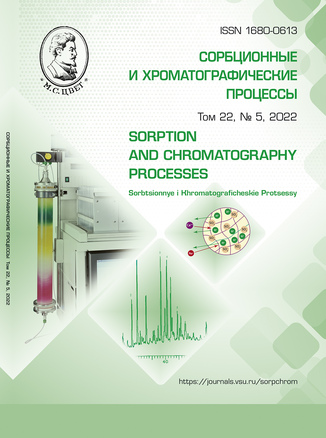Processing waste sulphate pickle liquor by acid retardation on a strong basic anion exchanger
Abstract
Waste pickle liquors (WPL), concentrated mixtures of salts and acids, are environmentally hazardous and need to be disposed of. The article uses a case study of real ironwork WPL containing more than
200 g/dm3 of iron sulphate and more than 65 g/dm3 of sulphuric acid to show a possibility of separating these components by the method of acid retardation on the strong basic anion exchanger AB-17x8 in the sulphate form. Processing involved batchwise passing of waste pickle liquor (stage of acid retardation) and the highly diluted aqueous sulphate solution (stage of acid displacement) through a layer of an anion exchanger. What is more, waste pickle liquor and the highly diluted aqueous sulphate solution were passed one after the other and in opposite directions. The article discusses the mechanism for separating the components, which is associated with a size effect, namely, the exclusion of highly hydrated ion pairs of the salt, which, to a lesser extent than the molecules or ion pairs of the acid, can penetrate into the nanoscale “pores” of the gel anion exchanger.
Another evidence of the mechanism of exclusion of neutral ion pairs rather than single ions is the possibility to separate acid and salt components in diluted solutions under the conditions when the Donnan effect of excluding coions from the ion exchanger phase cannot be neglected, which was shown in the work.
The article demonstrates the process of separating concentrated acid and salt without any liquid waste. It also presents experimental curves showing the possibility of obtaining a salt solution with a concentration almost equal to the concentration of iron sulphate in the initial mixture and an acid solution that can be reused in production. The salt solution may also be processed to produce an iron sulphate.
Downloads
References
Gao Ya, Yue T., Sun W., He D., Lu Ch., Fu X. Acid recovering and iron recycling from pickling waste acid by extraction and spray pyrolysis techniques. J. Cleaner Prod. 2021; 312: 127747. https://doi.org/10.1016/j.jclepro.2021.127747
Agrawal Archana, Sahu K.S. An overview of the recovery of acid from spent acidic solutions from steel and electroplating industries. J Hazard Mater. 2009; 171(1-3); 61-75. https://doi.org/10.1016/j.jhazmat.2009.06.099
Mu Naushad, Z. Al-Othman. A Book on Ion Exchange, Adsorption and Solvent Extraction, New York: Nova Science Publishers Inc., 2013, 321 p.
Hatch M.J., Dillon J.A. Acid Retardation. Simple Physical Method for Separation of Strong Acids from Their Salts. I&EC Process Design and Development. 1963; 2(4): 253-264. https://doi.org/10.1021/i260008a001
Ferapontov N.B., Gorshkov V.I., Trobov Kh.T., Parbuzina L.R., Gavlina O.T., Strusovskaya N.L. Reagent-free Separation of Electrolytes on Ion Exchangers. Russ. J. Phys. Chemistry A. 1996; 70(5): 840-843.
Ferapontov N.B., Gorshkov V.I., Parbuzina L.R., Strusovskaya N.L., Gagarin A.N. Thermodynamics of Interphase Equilibrium in System Ion Exchanger-Solution of Low Molecular Weight Electrolyte. React. Funct. Polym. 2006; 66(12): 1749-1756. https://doi.org/10.1016/j.reactfunctpolym.2006.08.005
Davankov V.A., Tsyurupa M.P., Alexienko N.N. Selectivity in preparative separations of inorganic electrolytes by size-exclusion chromatography on hypercrosslinked polystyrene and microporous carbons. J. Chromatography A. 2005; 1100(1): 32-39. https://doi.org/10.1016/j.chroma.2005.09.007
Davankov V., Tsyurupa M., Blinnikova Z., Pavlova L Self-concentration effects in preparative SEC of mineral electrolytes using nanoporous neutral polymeric sorbents. J. Sep. Sci. 2009; 32(1): 64-73. https://doi.org/10.1002/jssc.200800449
Krachak A.N., Khamizov R.K., Poznukhova V.A., Podgornaya E.B., Durnaykin V.A. Basic regularities of electrolyte separation in the method of Acid Retardation. I. Influence of cation type on the sorption of acids and their salts from binary solutions. Sorbtsionnye i Khromatograficheskie Protsessy. 2011; 11(1): 77-88
Khamizov R.Kh., Tikhonov N.A., Krachak A.N., Gruzdeva A.N., Vlasovskikh N.S. Separation of concentrated acid and salt solutions in nanoporous media as the basis for a new technology of processing of phosphorus-containing raw materials. Geochemistry International. 2016; 54(13): 1221-1235. https://doi.org/10.1134/S0016702916130085
Khamizov R.Kh., Krachak A.N., Podgornaya E.B., Gruzdeva A.N. Acid Retardation Effect in Sorption Columns with Two Liquid Phases: Capabilities of Application to Sample Preparation in Elemental Analysis. J. Analyt. Chemistry. 2019; 74(3): 226-238. https://doi.org/10.1134/S1061934819030079
Lur'e Yu.Yu. Analiz promyshlennykh stochnykh vod. M., Khimiya, 1984, 448 p.
Sidelnikov G.B., Tikhonov N.A., Khamizov R.K., Krachak A.N. Modeling and study of sorption and separation of acids in solution. Math. Models Comp. Simulations. 2013; 5(6): 501-510. https://doi.org/10.1134/S2070048213060112







